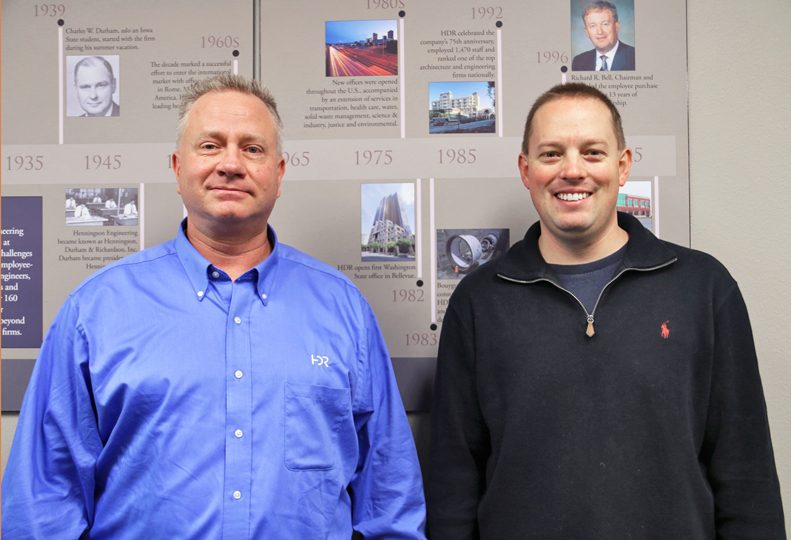
Home » HDR expands in Spokane
HDR expands in Spokane
Firm envisions future growth, revenue increase in region

November 9, 2017
The Spokane office of Omaha, Neb.-based engineering and architecture company HDR Inc. has grown its staff by a third here this year and plans to hire nearly a dozen more employees next year, says Todd Jensen, Spokane office co-lead and Eastern Washington water business lead.
The Spokane office occupies 12,000 square feet of space in the Iron Bridge I building, at 1401 E. Trent, where it has 37 employees, 15 of whom are engineers. At the beginning of this year, the staff at the Spokane office included 24 employees and occupied 7,500 square feet of space on the Iron Bridge Office Campus, Jensen says.
HDR leased an additional 4,500 square feet there in March and completed the expansion into that space in May.
Looking forward, he says HDR envisions either expanding into the second floor in the Iron Bridge I building or moving into another location.
That space could house a design center, which is still in the planning stages. If such a center were to be established, it would hold additional staff in a computer-aided design group; an architecture, structural, mechanical, electrical, and civil group; and other specialty personnel, says Jensen.
Jensen estimates the Spokane office will hire two water design engineers, two summer interns, two roadway design engineers, a railroad designer, and three substation design engineers next year.
HDR’s Spokane office works in civil engineering, construction management, electrical engineering, real estate, stormwater services, structural engineering, transportation-related engineering, water services, and wastewater treatment.
Companywide, HDR also offers architectural, construction, and environmental services, says Karen Doherty, Bellevue, Wash.-based Washington operations manager and a senior vice president.
The Spokane office works with other branches within the company and has architects from those offices fly to Spokane when needed, says Doherty.
“We like to go by HDR because we can reach out and find anyone that we need, so we try not to say we’re just HDR Engineering. We’re just HDR,” she says.
HDR also has an office in Coeur d’Alene, at 610 Hubbard. That office mainly focuses on transportation-related services and has 12 employees, three of whom are engineers, says Jensen.
Although Doherty declines to disclose annual revenue, she projects HDR’s Spokane office to see a revenue increase of 5 percent to 10 percent for the current fiscal year, she says.
Jensen says the Spokane office’s services typically fall into three main categories: water, electrical, and transportation.
Water services focus on pipelines, pump stations, booster stations, wastewater treatments plants, and stormwater facilities. That category also includes the hydropower group, which handles projects at dams, says Jensen.
The electrical group works on projects related to electrical distribution and substations, he says.
Scott Marshall, Eastern Washington transportation lead and co-office lead, says the transportation group works on projects associated with rail design for both heavy and light freight, bridge design, highway design, and transportation-related design for airports.
HDR recently designed the Flint Road realignment near Spokane International Airport. That project included redesigning the airport’s overhead signage and adding a restroom facility between the cell phone parking waiting lots, he says. He says Flint Road was along the rental-car return route, so maintaining traffic and an open roadway during construction proved challenging.
The transportation arm of the HDR here also just completed a bridge restructure project in Newport, Wash., and is working on other projects outside of state, including in Montana, Oklahoma, Texas, and New Mexico, he says.
Jensen says HDR worked on the Spokane County wastewater treatment plant, at 1004 N. Freya. The Spokane office provides ongoing assistance on the plant, he says, although the project was completed a few years ago.
Another project handled through HDR’s water services is the Mead-Mt. Spokane pump station and pipeline project, which provides sewer service to the business corridor in that region, he says.
Through its water services, HDR also helps clients that discharge treated wastewater into the Spokane River meet discharge permit requirements, he says.
A big part of the hydropower group’s job is to update technology in older dams, some of which were built in the 1930s and 1940s, says Jensen. The group’s services include equipment rehabilitation and upgrades, feasibility studies, and hydraulic modeling.
Some dams the group has worked on include Boundary Dam, Grand Coulee Dam, the Wanapum Dam, and the Wells Dam, all in Washington.
What sets the company apart is its ability to work on more complicated projects, Jenson asserts.
“We have the bandwidth to be able to do that,” he says.
Doherty says HDR has hired several interns from Gonzaga University, where Marshall and fellow engineer Aimee Navickis-Brasch are adjunct professors. The company has also been involved in students’ senior projects.
Established in 1917 in Omaha, HDR has more than 10,000 employees in 225 offices, says Doherty. The company opened its Spokane office in 1985 at 1817 E. Springfield.
HDR relocated the Spokane office to its current location in 2008. The company operates eight other offices in Washington state, including two offices in Seattle. The other Washington offices are located in Vancouver, Pasco, Bellevue, Edmonds, Gig Harbor, and Olympia. The company also has another Idaho office in Boise.
Jensen says HDR has a charitable foundation to which the company owners and employees can donate to. Last year, the company awarded a $10,000 grant to community action nonprofit Spokane Neighborhood Action Partners.
Latest News Up Close
Related Articles
Related Products
Related Events

![Brad head shot[1] web](https://www.spokanejournal.com/ext/resources/2025/03/10/thumb/Brad-Head-Shot[1]_web.jpg?1741642753)


![Final renderings building aerial cropped[2] web](https://www.spokanejournal.com/ext/resources/2025/03/13/thumb/Final-Renderings-Building-Aerial-cropped[2]_web.jpg?1741900849)